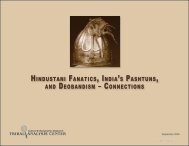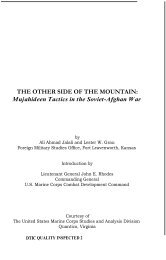The Baluch <strong>and</strong> <strong>the</strong> Brahui - <strong>and</strong> <strong>the</strong>ir Rebellionsnatural resources, <strong>and</strong> was immediately suspected of casting a covetous eye on a wide section of Baluchistan. Of particular suspected interest was<strong>the</strong> region surrounding Gwadar port, an area ruled by Oman at <strong>the</strong> time. Equally unfortunate for future Afghanistan-Pakistan relations, Prince KarimKhan <strong>and</strong> his followers relocated into sanctuaries within Afghanistan’s nearby K<strong>and</strong>ahar Province. Relations between <strong>the</strong> ancient state of Afghanistan<strong>and</strong> <strong>the</strong> new country of Pakistan had already been poisoned by dem<strong>and</strong>s for <strong>the</strong> creation of Pashtunistan, a vassal state for <strong>the</strong> Afghans that wouldhave stretched from today’s North-West Frontier Province’s nor<strong>the</strong>rn limits southward to <strong>the</strong> Arabian Sea. These conflicting claims developingover Baluchistan resulted in Pakistanis becoming increasingly angry as Afghanistan’s Durrani monarchy began to refer to <strong>the</strong> region as “SouthPashtunistan.” Prince Karim Khan’s arrival in Afghanistan did little to settle <strong>the</strong> frayed nerves among Pakistan’s new <strong>and</strong> inexperienced leadership. 11Prince Karim Khan’s short-lived revolt failed because of his inability to attract foreign support for <strong>the</strong> creation of an independent Baluchistan.Britain worked to ensure that Pakistan remained stable while <strong>the</strong> Afghan royal government remained unable to support Karim Khan alone. Stalin’sSoviet Union remained interested, but was non-committal because <strong>the</strong>y felt <strong>the</strong> greater opportunity for Soviet expansion lay with Pakistan. As aresult, Karim Khan was forced to return to Kalat where he continued his rebellion until he <strong>and</strong> his small group of followers were captured <strong>and</strong> jailed– by Pakistanis. In <strong>the</strong> wake of this unsuccessful revolt, relations between Pakistan <strong>and</strong> Afghanistan became increasingly bitter <strong>and</strong> as Pakistan’sPunjabis took greater control of Baluchistan’s resources, <strong>the</strong> Baluch tribes began to build grievances – toward Pakistan. Unfortunately, seeds of alasting type were being sown in very fertile tribal soil. Now <strong>the</strong> significantly weakened Brahui tribes were no longer able to act as a buffer between<strong>the</strong> Baluch tribes while tense relations between old Afghanistan <strong>and</strong> new Pakistan grew to <strong>the</strong> point that reconciliation was unlikely to occur. On oneside, Afghanistan wanted to see <strong>the</strong> creation of “Greater Pashtunistan” that would provide both resources <strong>and</strong> access to ports for <strong>the</strong> l<strong>and</strong>locked nationwhile Pakistan knew <strong>the</strong> Afghan goal would result in <strong>the</strong> loss of half of <strong>the</strong>ir national territory, leaving its two remaining provinces, Punjab <strong>and</strong> Sind,unable to survive economically – <strong>and</strong> militarily. Pakistan had just fought its first war with India <strong>and</strong> <strong>the</strong> concept of “Greater Pashtunistan” became alasting national survival issue for Pakistan.This situation worsened as Pakistan’s dominant population, <strong>the</strong> Punjabis, began to complain that Baluchistan comprised 40 percent of Pakistan’sterritory, but contained only four percent of its total population. Baluchistan’s tribes failed to recognize <strong>the</strong> Punjabi logic as a series of <strong>rebellions</strong>continued, culminating – to date – in a four-year outbreak of fighting in which Pakistan’s new army engaged <strong>the</strong> Baluch tribes that once fought a 30-year civil war among <strong>the</strong>mselves.Ano<strong>the</strong>r careful observer of tribal behavior, British officer C. E. Bruce who spent 35 years in <strong>the</strong> region following his fa<strong>the</strong>r’s 35 years, provideduseful insights into <strong>the</strong> relationship between <strong>the</strong> tribes <strong>and</strong> <strong>the</strong> emerging town-based <strong>and</strong> generally “de-tribalized” inhabitants:“…<strong>the</strong> politically minded of <strong>the</strong> official class, to which must be added <strong>the</strong> ‘middlemen,’ as well as <strong>the</strong> ‘intelligentsia,’were jealous of <strong>the</strong> tribal leaders. ‘They looked upon <strong>the</strong>m as revolutionaries <strong>and</strong> against <strong>the</strong> interests <strong>and</strong> aspirations of <strong>the</strong>educated classes.’ For, as Sir Henry Dobbs pointed out, ‘Civil officials are mostly educated Orientals brought up in towns, whohave a great dislike <strong>and</strong> suspicion of <strong>the</strong> tribes, <strong>the</strong> tribal organization, <strong>and</strong> <strong>the</strong> tribal chiefs, <strong>and</strong> more often than not are out todestroy <strong>the</strong>m by every means in <strong>the</strong>ir power.’ Written of Irak [sic], it was equally true of <strong>the</strong> frontier.” 12palace, removed records, <strong>and</strong> arrested Khan Ahmadyar Khan.11. http://en.wikipedia.org/wiki/Balochistan_conflict accessed 20 August 2009. Additional information is available in Selig Harrison’s “Nightmare in Baluchistan,” Foreign Policy,No. 32 (Autumn, 1978), pg. 145.12. Bruce, C.E., Waziristan, 1936-1937: Problems <strong>and</strong> Solutions, Aldershot: Gale <strong>and</strong> Polder, pg. 52.<strong>Tribal</strong> <strong>Analysis</strong> <strong>Center</strong>, 6610-M Mooretown Road, Box 159. Williamsburg, VA, 23188
Bruce also wrote about <strong>the</strong> position of <strong>the</strong> tribal leaders regarding <strong>the</strong> growing animosity with <strong>the</strong> emerging town elites:<strong>Tribal</strong> <strong>Analysis</strong> <strong>Center</strong>, 6610-M Mooretown Road, Box 159. Williamsburg, VA, 23188The Baluch <strong>and</strong> <strong>the</strong> Brahui - <strong>and</strong> <strong>the</strong>ir Rebellions“Up to now you have always worked through us. Just because a man can read <strong>and</strong> write it does not necessarily mean tha<strong>the</strong> is a better man or that he can control our tribes better than we can. Yet <strong>the</strong>se are <strong>the</strong> men you are putting over our heads<strong>and</strong> deferring to. And what have been <strong>the</strong> results?” 13Here lies <strong>the</strong> clue to underst<strong>and</strong>ing <strong>the</strong> tension between <strong>the</strong> rural tribes <strong>and</strong> <strong>the</strong> urban classes, led by Pakistan’s Punjabis, as <strong>the</strong>y looked at <strong>the</strong>l<strong>and</strong> <strong>and</strong> resources under <strong>the</strong> control of tribal chiefs from <strong>the</strong> Baluch <strong>and</strong> Pashtun ethnic groups. The process controlled by <strong>the</strong> urban elites that beganin 1947 is still underway that was described by C. E. Bruce:“…more often than not are out to destroy <strong>the</strong>m by every means in <strong>the</strong>ir power.”By 1973, Pakistan’s government had run to <strong>the</strong> limits of <strong>the</strong>ir patience with <strong>the</strong> Baluch tribes. Prime Minister Zulfikar Ali Bhutto imposed centralrule, arrested <strong>the</strong> principal Baluch leaders, <strong>and</strong> ordered 70,000 troops into <strong>the</strong> province. A student of Baluchistan’s politica, Selig Harrison, wroteaccurately about this stage of <strong>the</strong> Baluch rebellion:“At <strong>the</strong> height of <strong>the</strong> fighting in late 1974, American-supplied Iranian combat helicopters, some of <strong>the</strong>m manned by Iranianpilots, joined <strong>the</strong> Pakistani Air Force in raids on Baluch guerrilla camps. These AH-1J Huey-Cobra helicopters provided <strong>the</strong>key to victory in a crucial battle at Chamakung in early September when a force of 17,000 guerrillas of <strong>the</strong> Marri tribe, one of<strong>the</strong> 27 major Baluch subdivisions, were decimated.“… Allowing for distortion by both sides, nearly 55,000 Baluch were fighting in late 1974, some 11,500 of <strong>the</strong>m inorganized, hard core units. At least 3,300 Pakistani military men <strong>and</strong> 5,300 Baluch guerrillas as well as hundreds of women<strong>and</strong> children caught in <strong>the</strong> crossfire, were killed in <strong>the</strong> four year war….“Although military conflict between <strong>the</strong> Baluch <strong>and</strong> <strong>the</strong> central government dates from <strong>the</strong> creation of Pakistan in 1947,<strong>the</strong> wanton use of superior firepower by <strong>the</strong> Pakistani <strong>and</strong> Iranian forces during <strong>the</strong> 1973-1977 conflict instilled in <strong>the</strong> Baluchfeelings of unprecedented resentment <strong>and</strong> a widespread hunger for a chance to vindicate <strong>the</strong>ir martial honor.” 14By this time, Baluch guerrillas had been allowed to shelter in Afghanistan, once again implicating <strong>the</strong> Afghan government in <strong>the</strong> eyes ofPakistan’s leaders. But <strong>the</strong> impact was greatest on <strong>the</strong> Baluch tribes, especially <strong>the</strong> Marri tribe that suffered a military defeat <strong>and</strong> heavy losses at<strong>the</strong> h<strong>and</strong>s of <strong>the</strong> Pakistani <strong>and</strong> Iranian air forces – that flew American helicopters. For <strong>the</strong> Baluch tribes, not only was <strong>the</strong>ir tribal territory now split<strong>and</strong> occupied by Pakistan, Iran, <strong>and</strong> Afghanistan, instead of becoming Greater Baluchistan, <strong>the</strong>ir resources were now being appropriated for use inPakistan’s larger provinces, Sind <strong>and</strong> Punjab.One of <strong>the</strong> Baluch leaders predicted <strong>the</strong> future from his safe haven in Afghanistan:“If we can get modern weapons,” said guerrilla leader Mir Hazar at <strong>the</strong> Kalat-i-Ghilzai base camp in sou<strong>the</strong>rn Afghanistan,“it will never again be like <strong>the</strong> last time…. Next time we will choose <strong>the</strong> time <strong>and</strong> place, <strong>and</strong> we will take help where we canget it….” 1513. Ibid, pg. 54.14. Harrison, pg. 139.15. Harrison, pp. 139-140.
















